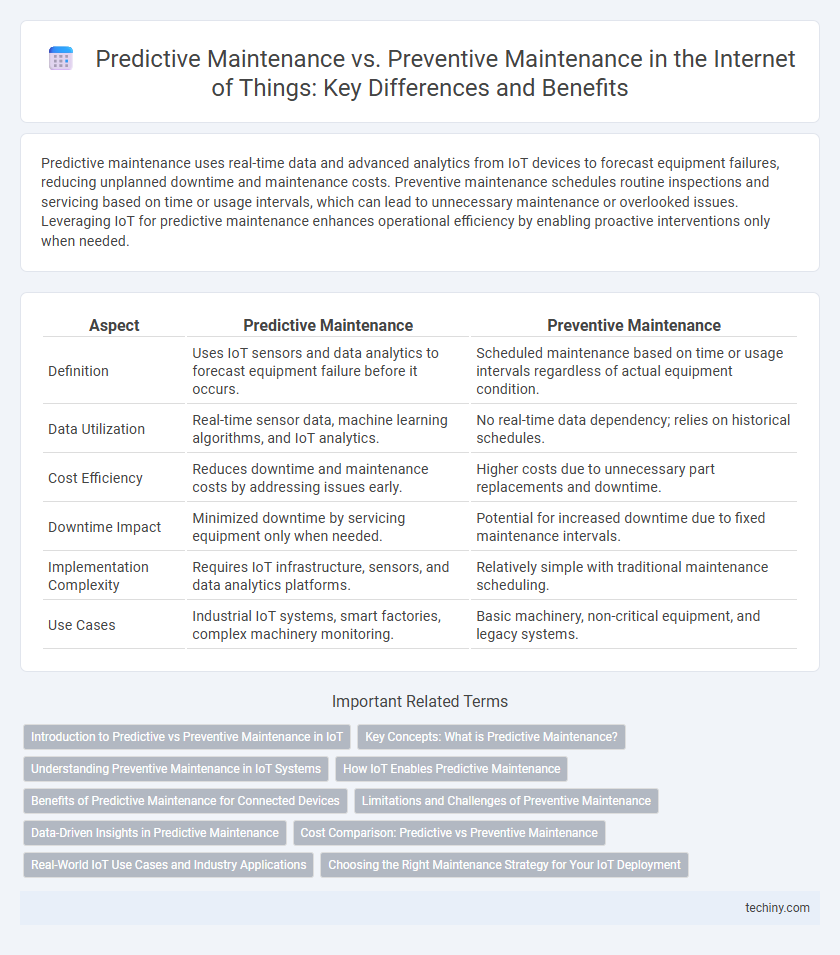Predictive maintenance uses real-time data and advanced analytics from IoT devices to forecast equipment failures, reducing unplanned downtime and maintenance costs. Preventive maintenance schedules routine inspections and servicing based on time or usage intervals, which can lead to unnecessary maintenance or overlooked issues. Leveraging IoT for predictive maintenance enhances operational efficiency by enabling proactive interventions only when needed.
Table of Comparison
| Aspect | Predictive Maintenance | Preventive Maintenance |
|---|---|---|
| Definition | Uses IoT sensors and data analytics to forecast equipment failure before it occurs. | Scheduled maintenance based on time or usage intervals regardless of actual equipment condition. |
| Data Utilization | Real-time sensor data, machine learning algorithms, and IoT analytics. | No real-time data dependency; relies on historical schedules. |
| Cost Efficiency | Reduces downtime and maintenance costs by addressing issues early. | Higher costs due to unnecessary part replacements and downtime. |
| Downtime Impact | Minimized downtime by servicing equipment only when needed. | Potential for increased downtime due to fixed maintenance intervals. |
| Implementation Complexity | Requires IoT infrastructure, sensors, and data analytics platforms. | Relatively simple with traditional maintenance scheduling. |
| Use Cases | Industrial IoT systems, smart factories, complex machinery monitoring. | Basic machinery, non-critical equipment, and legacy systems. |
Introduction to Predictive vs Preventive Maintenance in IoT
Predictive maintenance in IoT leverages real-time sensor data and advanced analytics to anticipate equipment failures before they occur, optimizing operational efficiency and reducing downtime. Preventive maintenance relies on scheduled inspections and routine servicing based on time or usage intervals, often leading to unnecessary maintenance activities or unexpected breakdowns. Integrating IoT technologies enhances the accuracy of predictive models, enabling dynamic maintenance strategies that adapt to actual equipment conditions rather than fixed schedules.
Key Concepts: What is Predictive Maintenance?
Predictive maintenance in the Internet of Things (IoT) leverages real-time data from connected sensors and advanced analytics to forecast equipment failures before they occur. This approach prioritizes condition-based monitoring, utilizing machine learning algorithms and historical performance data to optimize maintenance schedules and reduce downtime. IoT-enabled predictive maintenance enhances operational efficiency by enabling proactive interventions only when necessary, minimizing unnecessary maintenance costs compared to traditional preventive maintenance.
Understanding Preventive Maintenance in IoT Systems
Preventive maintenance in IoT systems involves scheduled inspections and routine servicing of connected devices to reduce the risk of unexpected failures and extend equipment lifespan. This approach uses sensor data to identify potential wear and system inefficiencies before breakdowns occur, minimizing downtime and maintenance costs. Integrating preventive maintenance with IoT analytics enhances asset management by enabling timely interventions based on real-time operational data.
How IoT Enables Predictive Maintenance
IoT enables predictive maintenance by continuously collecting real-time data from connected sensors embedded in machinery, allowing for advanced analytics and machine learning algorithms to detect patterns and predict equipment failures before they occur. This data-driven approach reduces downtime, extends asset lifespan, and optimizes maintenance schedules compared to traditional preventive maintenance methods that rely on fixed intervals or time-based inspections. IoT platforms integrate with cloud computing and edge devices to process vast amounts of sensor data, enabling timely decision-making and efficient resource allocation.
Benefits of Predictive Maintenance for Connected Devices
Predictive maintenance leverages real-time data from connected devices in the Internet of Things (IoT) ecosystem to forecast equipment failures, significantly reducing unexpected downtime and maintenance costs. By analyzing sensor data and machine learning algorithms, it enables precise maintenance scheduling that maximizes asset lifespan and operational efficiency. This data-driven approach ensures higher reliability and optimizes resource allocation compared to traditional preventive maintenance strategies.
Limitations and Challenges of Preventive Maintenance
Preventive maintenance in the Internet of Things (IoT) context faces challenges such as over-maintenance, leading to unnecessary downtime and increased costs due to fixed schedules rather than actual equipment conditions. Its limitations include the inability to predict unexpected failures accurately and inefficient resource allocation since maintenance is performed regardless of machine health status. These factors hinder optimal asset utilization and reduce the potential benefits of IoT-driven data analytics for maintenance optimization.
Data-Driven Insights in Predictive Maintenance
Predictive maintenance leverages real-time sensor data and advanced analytics from Internet of Things (IoT) devices to forecast equipment failures before they occur, minimizing downtime and maintenance costs. Data-driven insights enable precise identification of potential issues by analyzing machine performance trends, vibration patterns, and temperature fluctuations. This approach contrasts with preventive maintenance, which relies on scheduled inspections rather than continuous condition monitoring.
Cost Comparison: Predictive vs Preventive Maintenance
Predictive maintenance leverages IoT sensors and real-time data analytics to detect equipment anomalies before failures occur, significantly reducing unplanned downtime and maintenance costs. Preventive maintenance follows scheduled intervals regardless of equipment condition, often leading to unnecessary maintenance activities and higher labor expenses. Studies indicate predictive maintenance can cut maintenance costs by up to 30%, optimize resource allocation, and extend asset lifespan compared to the more rigid, time-based preventive approach.
Real-World IoT Use Cases and Industry Applications
Predictive maintenance leverages IoT sensors and real-time data analytics to forecast equipment failures, reducing downtime and maintenance costs in industries such as manufacturing, oil and gas, and transportation. Preventive maintenance involves scheduled inspections and part replacements based on historical data, commonly applied in utilities and facility management to avoid unexpected breakdowns. Real-world IoT use cases demonstrate that predictive maintenance optimizes asset performance by enabling condition-based interventions, while preventive maintenance ensures safety and compliance through routine upkeep protocols.
Choosing the Right Maintenance Strategy for Your IoT Deployment
Predictive maintenance leverages real-time IoT sensor data and advanced analytics to anticipate equipment failures, reducing unplanned downtime and optimizing asset lifespan. Preventive maintenance follows scheduled inspections and replacements based on predefined intervals, aiming to prevent breakdowns but often resulting in unnecessary maintenance activities. Selecting the right strategy depends on the criticality of the assets, data availability from IoT devices, and the operational cost-benefit balance for your specific IoT deployment.
Predictive maintenance vs Preventive maintenance Infographic

 techiny.com
techiny.com